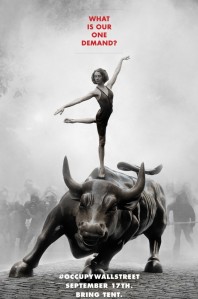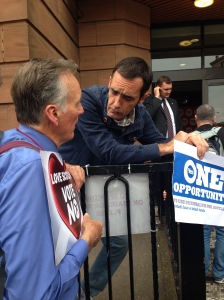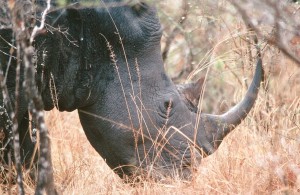Published in the Hilary Term issue of ISIS
“To me this is a kind of oxymoronic madness, I can’t believe that human beings are being so stupid at this moment in human history. We’re still telling each other we have to consume more to get out the fix that we’re in which was caused originally by the fact that we consume too much.” Kalle Lasn speaks with the energy of an agitator. Behind his soft Estonian accent lies the story that transformed him into a radical thinker.
He was born in Estonia in 1942 and spent time in a German refugee camp before his family moved to Australia. It was during the 1960s, when he had set up a market research company in Tokyo, that his worldview started to change. “I was making money like you wouldn’t believe… and yet, all the people around me who worked for all those advertising agencies that were my clients, you know all of a sudden I got bored with those guys. All they did was go around at night and fuck around and whenever I started talking about anything meaningful then they didn’t really want to talk about it.”
This disillusionment grew and, after making films and documentaries for PBC in Canada for twenty years, Lasn founded Adbusters in 1989. Through this left-wing, non-profit magazine, which features clever spoof adverts, poetry and short opinionated articles, Lasn put his ideas on a global stage and provided the stage for others.
Adbusters uses branding masterfully. Its images accuse corporations of perverting consumers, ironically using consumerism’s own weapons against itself. “It’s a process we’re all caught up in and there’s nothing we can really do about it… that process pumps thousands of marketing messages into our brains every day whether we like it or not.” Spoof adverts attack consumerism in the same way as genuine adverts support it. For twenty years the magazine has been running ‘buy nothing day’ and ‘TV turnoff week’.
But on September 17th 2011 the greatest branding exercise to date came to fruition. Thousands occupied Wall Street, and over the next few months occupied streets all over the world – #occupywallstreet.
When this message was printed in Adbusters they never expected it to reach so many. “That spark, the occupy movement – and now at Adbusters we’re saying ok, what’s next? How can we push this human experiment of ours on planet earth into orbit?”

Lasn sees the “huge threat” of ecological degeneration and climate change, the failure of the foundations of neoclassical economic theory which “aren’t working any more”, and the “mental breakdown of humanity” – shown by increasing numbers of people with mental disorders – as evidence that the current system is failing. “This human experiment of ours on planet earth has never been more shaky [than] it is today.”
The Pussy riots in Russia, uprisings in Egypt and the Arab world, protests in Spain, Greece, Chile and Bolivia are all part of this same undercurrent of restlessness that was behind the occupy movement and even the 2011 London riots, he believes. The ecological, economic and psychological problems result from the failure of the current system and “all add up to this… very scary gut feeling among some young people that the future doesn’t compute anymore.”
“Most of the students at Oxford and most people in North America and the one billion rich people in the world, we’re still doing pretty damn ok” Lasn says as he reaches the height of his crescendo. But he predicts “there will be a crash moment, a financial or ecological crash… if we do have a crisis moment then things could move very fast.”
In recent years critics of the left have attacked them for identifying problems and not solutions. Lasn believes that the feeling of frustration among young people is the start of a longer revolution, and the lack of viable solutions is to be expected, citing past revolutions when the ideas have come after initial unrest. “Even though up to now we haven’t come up with any big ideas, those big ideas are percolating in the background.”
But what is the ideological framework for this movement? “Well ideology is kind of an old word, now things are more fragmented… I don’t think it [capitalism] is going to be suddenly replaced by a totally new system… it will become capitalism 2.0 maybe” he laughs.
In his new book, Meme Wars: The Creative Destruction of Neo-Classical Economics, Lasn depicts the flaws of neo-classical economics. It is not radically new, but uses the work that some economists, such as contributors Joseph Stiglitz and George Akerlof, have been working on for a long time. He sees the current economic system as unsustainable because it ignores the fact that resources are renewable and that we live on a vulnerable planet. It makes humans selfish he says, and has caused them to abuse the planet.
He speaks with the precision of someone who has taken English as a second language. “30% of the world economy is money making money making money ad nauseam… that aspect of capitalism will morph into 2.0”. A Robin Hood tax which would take a 1% tax from all financial transactions and the banning of flash trading would both be part of Lasn’s idea of ‘capitalism 2.0’. “We will figure out the costs of our doing business” with a two-cost market regime which takes into account the ecological cost of products.
Lasn believes this reality will be won through communication technology. “It’s going to be brought about by young people with social media tools.”
And what have Adbusters got lined up to kick-start world revolution? Lasn envisages a #Goldman campaign. A twitter campaign that goes viral “and suddenly all 72 branches of Goldman Sachs are thrashed all over the world.” He says, speaking quickly and eagerly. He realises “our ability to vent our anger at these financial fraudsters who brought on the meltdown four years ago,” and adds that “that anger hasn’t subsided.”
The #kickitover campaign aims to inspire uprisings in economics departments in universities across the world. “My great wish would be that the economics students at Oxford, that they start putting up posters… and asking their professors, you know, how they measure progress and how come they didn’t see the meltdown coming four years ago, and I hope Oxford can once again play a role in shaping the economic paradigm.” Lasn is particularly animated when talking about the nearly 100 Harvard students who, in November 2011, walked out of Greg Mankiw’s class in protest. The #kickitover campaign aims to take this to a new level.
There are also plans for a video game, #killcap, which involves the player trying to defeat capitalism. The tag line reads: “EA Sports – challenge everything”
But when Lasn starts talking about “an apocalypse and a thousand year dark age” I immediately become skeptical. Maybe it’s because, as Lasn says “capitalism does have a style, a tone, a form, a kind of a feeling we all live by, it’s a process we’re all caught up in and there’s nothing we can really do about it.” Maybe I am too caught up in it. But I wonder whether there has ever been a generation in which at least some have not felt that the future “doesn’t compute”.
Is it tenuous to link Pussy riots, the reaction to corruption in Russia, and the anarcho-marxist Zapatistas in Mexico? Perhaps. Has there ever been a generation where at least some haven’t believed the world is about to end? I doubt it. And what makes me even more suspicious is that I know many of the things Lasn says are buzz words that repeatedly feature in his other interviews and in Adbusters. “Capitalism seems to be tankering and faulting in a big way”, “the future doesn’t compute”, “morph”. Adbusters is all about trendy slogans: ones that you’ll remember and spread, ones that can start revolution.
But this isn’t a mad has-been lefty. This is a man and organisation that clearly have the power to motivate thousands through their adept use of imagery, words and the internet. The ideas are not peripheral either. The reality of psychological degeneration in the West is supported by a lot of evidence and Lasn’s new book debunking current economic thought has seemingly been received with acclaim. The existence of climate change can hardly be refuted. Whatever you believe, the potential power of the Adbusters campaign is undeniable. As Lasn says “It could take a generation… but people are waking up to the fact that what we are doing isn’t sustainable.”
“We’re living in a very dangerous but hopeful moment in human history,” Lasn whispers excitedly . “We have the possibility of pulling off a singularity, a one-time mind shift. A revolutionary moment in human history when suddenly we morph into a new orbit and start doing things right.”
















